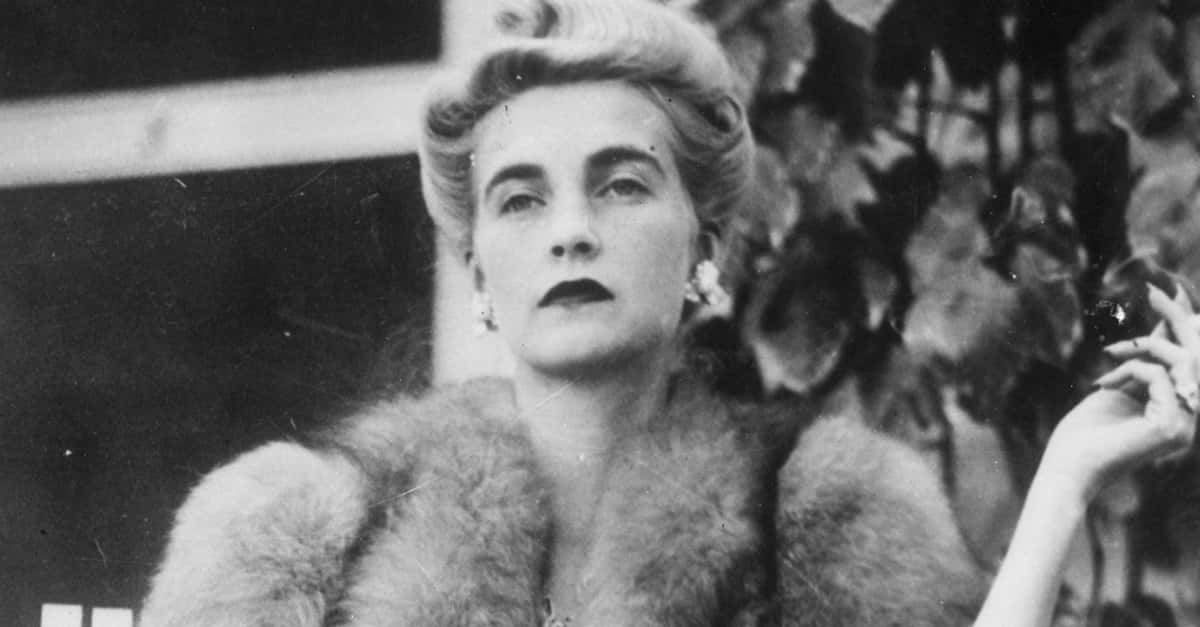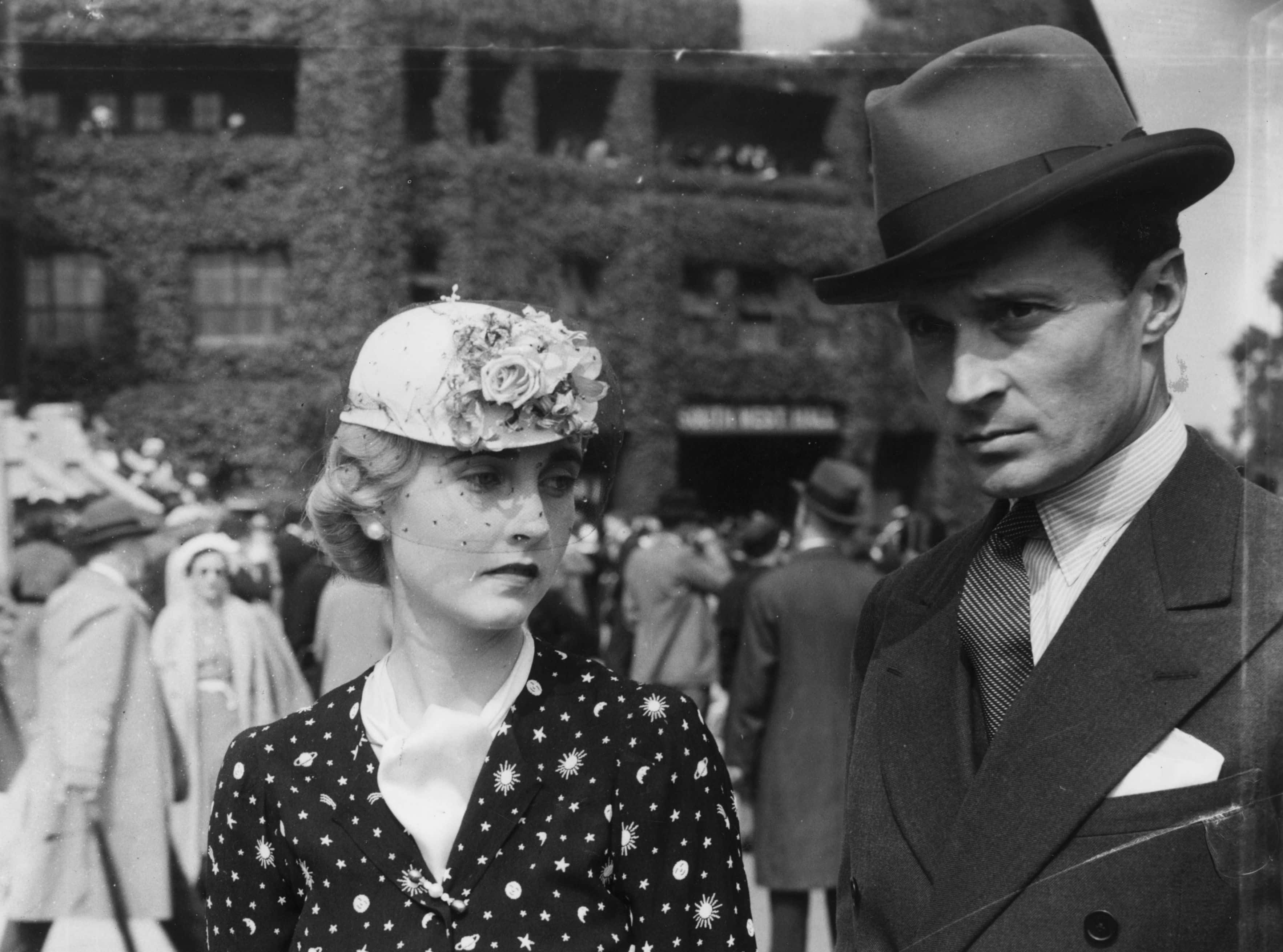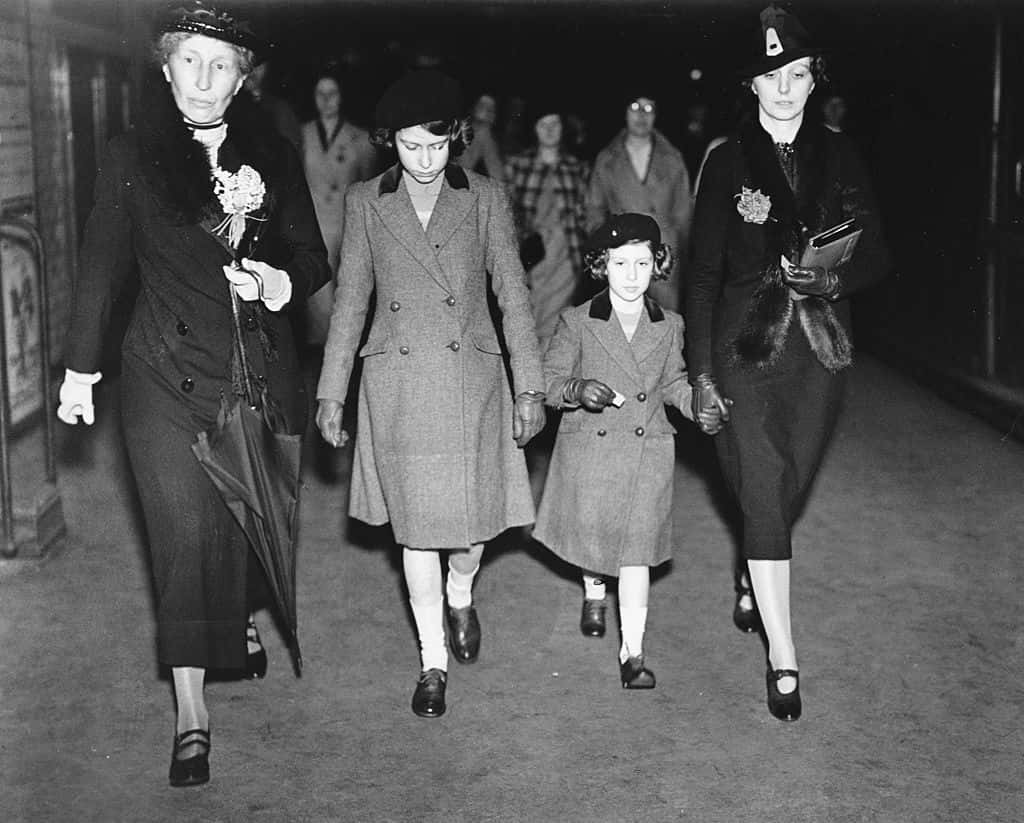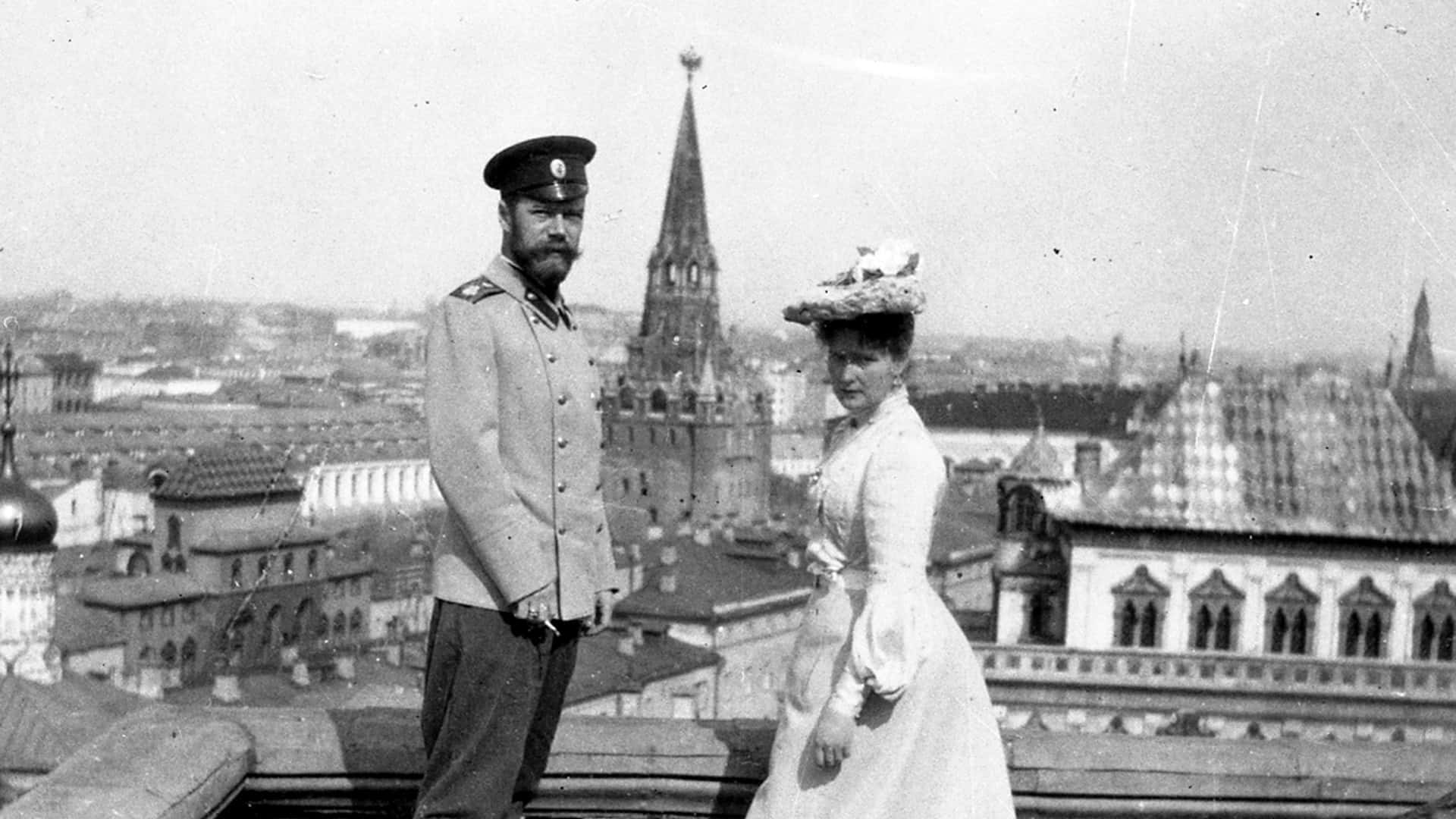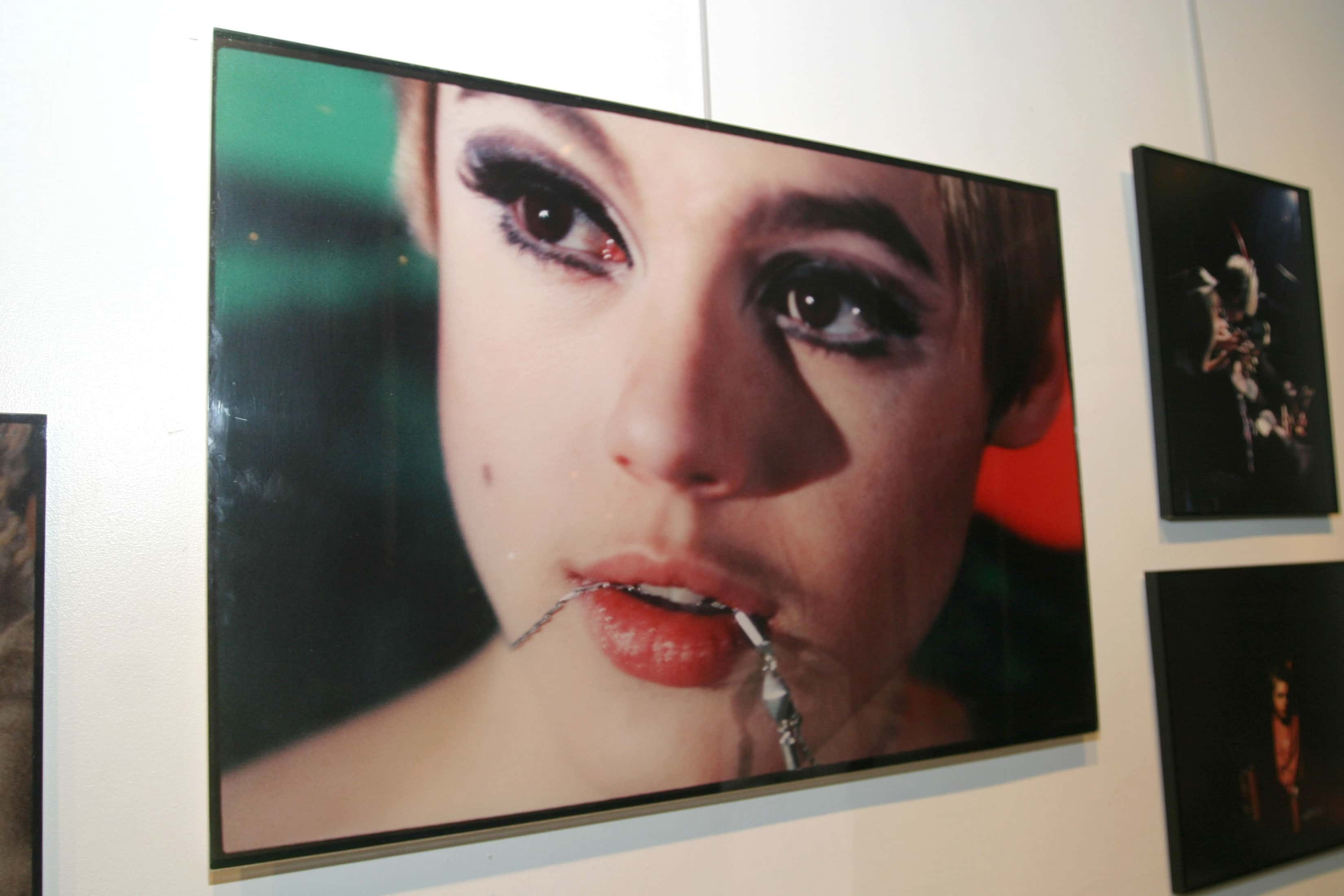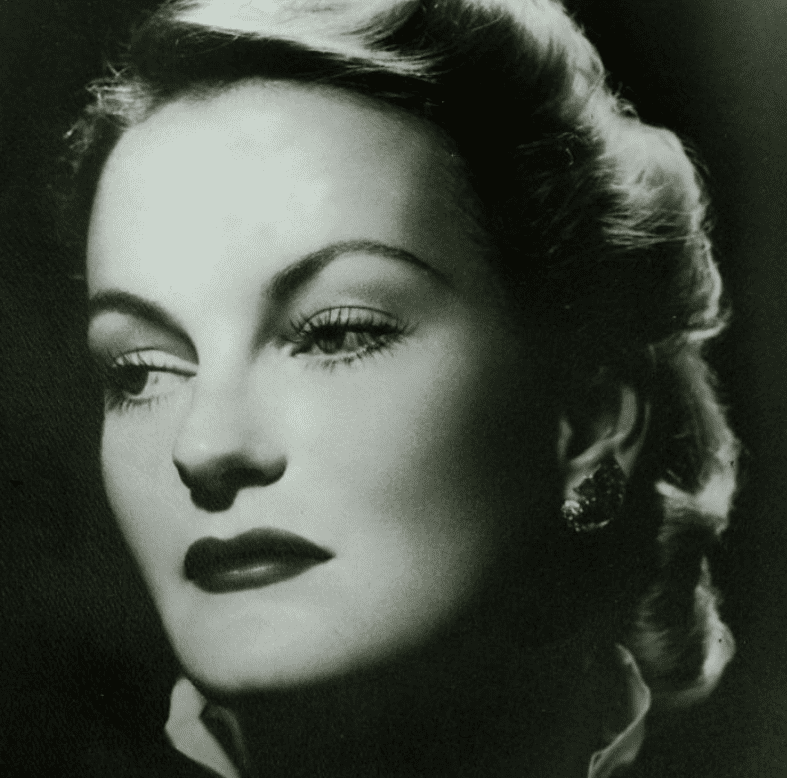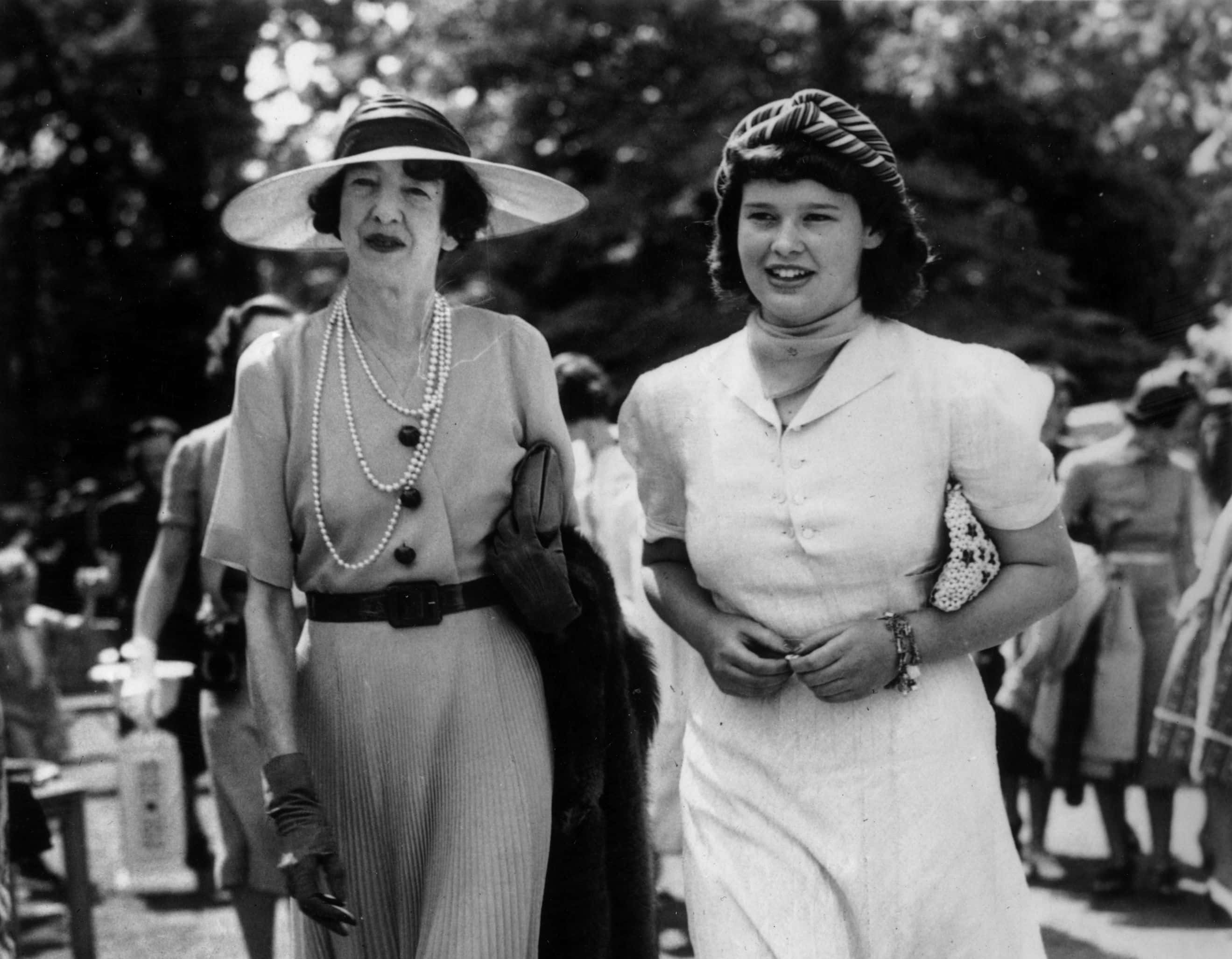History's Doomed Heiresses
Everyone's heard that money can't buy happiness, though to people outside the upper crust, that statement can sound a little rich. Most of us will never know what it's like to drown in wealth, though these heartbroken heiresses have first-hand experience.
From doomed royals like Princess Margaret and Anastasia Romanov to tragic scions like Barbara Hutton and Gloria Vanderbilt, these poor little rich girls prove that all that glitters is definitely not gold.

1. A Female Richie Rich
Way before Paris Hilton and Kim Kardashian, there was Barbara Hutton. This "poor little rich girl" made headlines because of her many affairs, her lavish lifestyle, but most especially her tragic beginning and end. Though her name might not make the papers today, she was the heiress of the 20th century.

2. Poor Little Rich Girl
Barbara Hutton was the only child of Edna Woolworth, an heiress to the Woolworth dime-store fortune. The paternal side of the Hutton family tree was nothing to sneeze at, either: Barbara's father Franklyn Laws Hutton founded an investment banking and stock brokerage firm in New York. In other words: money money moneyyyy.
3. The Royal Wedding(s)
Hutton's long list of ex lovers reads like a royal decree. She married three princes, one count, one baron, and a diplomat—plus one Hollywood mega-star, Cary Grant. Sadly, all of these marriages ended in tragedy, but we'll get to that...
4. Desperate Housewife
The Hutton family may have seemed happy on the surface, but nothing could be further from the truth. Franklyn was a cruel father and an infamous philanderer, and Edna responded to his infidelities by having revenge affairs of her own. Barbara, meanwhile, was lost in the shuffle, and spent most of her childhood with nurses or governesses.
5. A Tragic Childhood
When Hutton was only five years old, utter tragedy struck. Her mother Edna perished under very mysterious circumstances—and though the official story said she perished from an ear infection, the rumors were a lot darker. Many claimed Edna actually took her own life because of her chronically unhappy and unfaithful marriage.
The Huttons went to great lengths to suppress the truth, even paying off city officials to avoid an autopsy.
6. Growing up Too Fast
Tragically, it was reportedly little Barbara who found her mother's body.
7. Lonely in Luxury
After her mother’s untimely demise, Hutton’s father left her with her maternal grandparents. Even then, it was far from happily ever after. Her grandmother had premature dementia, leaving the little girl to filled her time by eating in silence in the formal dining room. Thankfully, Hutton's grandfather adored her. She stayed with him until his passing in 1919.
8. My Only Friend
Because of her lonely childhood, one of Hutton's only friends was her cousin Jimmy Donahue. Unfortunately, he had a sinister side. Donahue inherited some bad habits from his family, including a substance use problem that he then introduced to Hutton. Drug dependency would follow her for the rest of her life.

History's most fascinating stories and darkest secrets, delivered to your inbox daily.
9. Mirror, Mirror on the Wall
Thanks in part to her horrific childhood, Hutton thought she was “ugly, fat, and awkward” and utterly undeserving of love. To make matters worse, she often felt that if anyone did love her, it would only be because of her money and not because of her own qualities. Sadly, her fears turned out to be eerily prophetic...
10. The Ball That Sank a Thousand Ships
No high society girl's life is complete without a debutante ball, and Hutton had hers in 1930 when she turned 18—except it was an absolute disaster. Oh sure, it was luxurious enough: The guest list was full of Astors, Rockefellers, and Vanderbilts, and the cost of the event's flowers alone was in the tens of thousands.
So what was the trouble? This was right at the start of The Great Depression, and Hutton's lavish coming out party cost three times more than any of the other balls held at the time. The public—and the vengeful press—thought the vulgar display of wealth was incredibly tone deaf for the lean times. C'mon, read the room, Barbara.
11. The Marrying Mdivanis
Hutton met the dashing Alexis Mdivani in France when she was barely in her 20s, but her beau was hiding a dark secret. The Mdivani family said they were Slavic royalty, when really, they were notorious social climbers known as the "Marrying Mdivanis". Alexis's sister Roussie orchestrated his meeting with Hutton, while Alexis was already married—to Hutton's good friend Louise Van Alen.
12. Leave It to Roussie
Roussie Mdivani was determined to get her brother Alexis a rich bride, and so she came up with a cruel but ingenious plan. One day, Roussie arranged it so that Barbara and Alexis were alone in a country cottage together. When Alexis started putting on the moves, the rest of the group "discovered" them and pretended to be outraged at the scandal.
Roussie then blackmailed Hutton with negative press attention unless she married her dear brother. The unhappy couple were wed on June 22, 1933, and Hutton's father provided a tidy $1 million dowry to the swindlers.
13. Second Chance
Hutton was chronically unlucky in love. She announced her second marriage to Count Kurt Haugwitz-Reventlow a bare 24 hours after her divorce from Alexis Mdivani went through, and the union only got worse from there. Obsessed with her fortune, Reventlow forced Hutton to become a Danish citizen so she would pay less taxes. The press viciously bombarded Hutton's decision, but the public outcry was nothing compared to the real horrors of Hutton's marriage.
14. Don't Count on Me
By all accounts, Hutton's second husband Count Reventlow was a nasty piece of work—and his tax evasion was just the beginning of the nightmare. He was emotionally and physically abusive to Hutton, and even once beat her so badly, she had to be hospitalized. Proving there is some justice in the world, Reventlow was thrown in prison.
15. Cary-ed Away
In Hutton's case, third time really was the charm. Her 1942 marriage to Hollywood actor Cary Grant was probably her most successful union, though that bar was really low. Nonetheless, Grant seemed to have genuine feelings for Hutton and vice versa. Moreover, with his own successful acting career making bank, he didn't need her money. For a short time, it must have felt like paradise.
16. Wealthy But Unhealthy
By the end of her life, Hutton had developed a rampant eating disorder—and its origin story is heartbreaking. According to some, the habit really crystallized after her first husband Alexis Mdivani called her "too fat" on their wedding night. Hutton quickly went on a crash diet, drinking only black coffee for weeks at a time and dropping around 40 pounds.
17. All Time Reventlow
Hutton's self-harm only increased with her second marriage to Count Reventlow; after her first child Lance, her anorexia was so bad that she couldn't biologically have any more children. As the years went on, Hutton also depended on illicit substances and booze, and by the end of her life, Hutton felt so weak and sad that she often refused to get out of bed.
18. If They Can't Make It, Who Can?
Sadly, Hutton and Cary Grant's marriage was doomed to a heartbreaking end. Hutton simply couldn't get over the psychological scars left from a lifetime of manipulation and mistreatment, and Grant despised her insecure and uncontrollable need to surround herself with “a consortium of fawning parasites". After three years of marriage, they divorced in 1945.
19. Four Times a Fool
After divorcing Grant, Hutton claimed she would never marry again because she could “not go on being a fool forever". Well, she was a fool again. In 1948, she married her fourth husband, the impoverished Russian prince Igor Troubetzkoy. When their relationship fell apart, Hutton's reaction was utterly disturbing. She attempted to end her life. The story caught flame with the press, who soon gave her the lasting moniker "the poor little rich girl".
20. Pretty Vicious
In the early 20th century, socialites had infamously bitter rivalries—but Hutton's feud with Doris Duke is legendary. Once childhood friends, the women grew to hate each other. Duke envied Hutton’s beauty, while Hutton called Duke “cheap". The last straw came when Hutton married Duke's ex-husband, the famously well-endowed Porfirio Rubirosa.
21. Blink and You'll Miss It
Hutton's marriage to Rubirosa was her shortest: It lasted all of 53 days, and it turned out that Rubirosa was having an affair with Tinseltown diva Zsa Zsa Gabor the entire time. Despite this, Rubirosa made a fortune in the divorce proceedings, acquiring a string of polo ponies, a plane, a coffee plantation, and millions of dollars in settlement from his ex-wife.
22. Homestyle Showdown
Doris Duke once invited Hutton over to her mansion in Hawaii while she was gone—but she quickly regretted it. Instead of behaving like any other guest, Hutton took it upon herself to entirely redecorate the abode, throwing out Duke's antiques and replacing them with modern Japanese pieces. When she came home, Duke understandably forced Hutton out.
23. Final Heartbreak
Hutton didn’t have a happy life by any means, but the final strike was the most tragic. In 1927, her beloved son Lance perished in a plane crash at only 36 years old. Now truly alone, Hutton was overcome with grief and never truly recovered. People close to her claimed she lost all interest in living after the senseless accident.
24. The End of Hutton
The last chapter of Hutton’s life was as tragic as the first one. She passed on in Los Angeles's Beverly Wilshire Hotel in 1979 from a heart attack at just 66 years old. Sadly, just 10 people attended her funeral.
25. Not a Sleeping Beauty Story
Born to wealth herself, Eva Kemeny met her match in Hans Kristian Rausing, the heir to the Tetra-Pak packaging fortune in the 1990s. At the time, they were both in rehab. Both appeared to feed each other’s worst habits, i.e. illicit substances. In 2012, Hans’ arrest for Class A drug possession led to a raid of the couple's $70 million-dollar home. Law enforcement found that the mansion ravaged by squalor, but the nightmare was just beginning. They soon discovered Eva's lifeless body. It had been decomposing for two months.
26. My Favorite Way for Rich Friends to Cope Too
Lady Henrietta Guinness—yeah, of that Guinness brewing fortune—once said, “If I had been poor, I would have been happy". Alienated by her own wealthy birth, Henrietta coped by bestowing extravagant gifts upon her pals. She once bought a $70,000 hair salon for her hairdresser and a $28,000 Belgravia restaurant for her Italian chef fiancé. The pair never married, but at least they enjoyed the eatery. And hey, food > love any day.
27. The Highborn Falls Harder
Despite a life of generosity, Guinness heiress Lady Henrietta met a mysteriously violent end. On May 3, 1978, she took her own life in grisly fashion. She climbed up the Ponte delle Torri bridge and fell to her doom at the age of 35. Fifteen years earlier, Henrietta suffered intense hospitalization and depression after a car crash. To this day, however, no one is sure what pushed her over the edge.
28. A Woman’s Right to Choose (Badly)
Nancy Astor is a complicated heiress. On one hand, the Gilded Age American is celebrated for her charity and women’s rights advocacy, and for becoming the first elected female representative in the UK House of Commons. On the other hand, Astor was an outspoken supporter of the Nazis before WWII. History thus extended “mixed” feelings to her legacy. Her famous helping hand did not extend to everyone...
29. Bark If You’re a Beneficiary
Not all heiresses are human. In 2014, wealthy accountant Rose Anne Bolasny left a $100,000 per year trust to her Maltese dog, Bella Mia. In a swoop, the pup became the richest non-human animal (and non-human heiress) in the world.
30. Prime Minister’s Mom Likes to Party
History best remembers Lady Randolph Church as the mother of British Prime Minister Winston Churchill. But Lady Randolph stoked more than enough scandal to be remembered in her own right. She was one of the notorious heiresses to her financier father’s fortune. If you believe the high society rumor mill, Lady Randolph took lovers while married.
Plus, her party-girl ways were so legendary that history often (falsely) credits her with the invention of the Manhattan cocktail.
31. The Not So Sweet Life of Casey Johnson
Casey Johnson was heiress to the Johnson & Johnson estate, but one might not have known it from her life of squalor on Mulholland Drive. The heiress had longtime struggles with substance use and drinking. It got so bad that Johnson’s family cut her off until she agreed to enter rehab. Unfortunately, the tough love approach backfired.
In 2010, the 30-year-old Johnson was discovered lifeless by her maid. The official cause of her demise was “diabetic ketoacidosis,” a condition onset by lack of insulin for her diabetic needs.
32. Improper Princess
Little siblings are often expected to wallow in the shadow of their big brothers and sisters, especially if their older siblings is the Queen of England. Princess Margaret is the surprising exception to this rule. While most of the British royal family is prim and restrained, Princess Margaret walked a different path with her wild affairs and scandal-filled youth.
33. Spare the Curfew, Spoil the Child?
As a child, Margaret gained a public image as a bit of a spoiled brat. This reputation was partly because she got to sit back from royal duties. She wasn’t expected to take up official public duties during the war or during other ceremonies. Most scandalously, Margaret was allowed to stay up past dinner when she was only 13 years old—an indulgence for which her father King George VI got criticism. What constituted a “spoiled” child was very different in the 1940s.
34. Drama Queen-in-Waiting
The princesses’ governess, Marion Crawford, often lamented that Margaret’s showboat behavior spoiled the royal family. Crawford even once wrote friends, “Could you this year only ask Princess Elizabeth to your party? [...] Princess Margaret does draw all the attention and Princess Elizabeth lets her do that". When your nanny asks for you to be snubbed, you know you’re a drama queen—or is that drama princess?
35. A Princess Never Settles for Seconds
The year 1952 was a mixed bag for Princess Margaret. For starters, her father kicked the bucket. She was now the queen’s 22-year-old sister. However, this was also the year that Margaret met her great love, Captain Peter Townsend. 16 years older than Margaret, Townsend had divorced his first wife and planned to marry Margaret. Unfortunately, the couple was doomed to a heartbreaking end. The whole “divorced suitor” thing didn’t sit well with the Church of England, of which Margaret’s sister was now the Supreme Head…
 Wikimedia Commons
Wikimedia Commons
36. A Royal Waiting Period
Queen Elizabeth II didn’t immediately veto Margaret’s romance with Peter Townsend. Instead, the Queen asked her sister to wait a year, so her Majesty could deal with their grandmother Queen Mary’s funeral, plus her own coronation and upcoming six-month world tour. A scandalous match between a royal and a divorcee—for the second time in recent memory—would be just too much on Elizabeth’s plate.
37. A Matter of Heart and State
From the looks of things, it was the government—not Margaret’s sister—who got in the way of her would-be marriage to Peter Townsend. The media and the British Cabinet refused to countenance the marriage between a princess and a divorced commoner, lamenting how such a match would “fly in the face of Royal and Christian tradition". Prime Minister Winston Churchill himself told the Queen that the leaders of the Dominion would all vote “No” on the marriage unless Margaret gave up her rights to inherit the crown. Ouch.
38. It’s Him or Us
Although the government made their anti-Townsend stance clear, in a heartrending gesture, the common people supported Margaret’s personal choice. The Church said otherwise, telling the Princess herself that they would refuse to give her communion if she dared to marry the divorced Townsend.
39. The Final Word on the Subject Wasn’t Hers
On Halloween 1955, Princess Margaret officially renounced her intention to marry Peter Townsend in an official statement. She said, “I have reached this decision entirely alone, and in doing so I have been strengthened by the unfailing support and devotion of Group Captain Townsend". Considering the amount of pressure that she was under, we have to raise a royal eyebrow at how “alone” she was in this decision.
40. Europe Isn’t a Fan of Photographers
Rebounding from her heartbreaking split with Townsend, Princess Margaret fell madly in love with the photographer Antony Armstrong-Jones. While Armstrong-Jones wasn't divorced, he wasn't royal either, and the regal community raised their eyebrows at Margaret's romantic choice for the second time. Even so, Margaret would not be deterred. She married the photographer...with exactly one foreign royal attendee at her 2000+ guest wedding: Queen Ingrid of Denmark.
41. More Is Not Always Merrier
Rumors of adultery on Margaret’s part would follow the princess through the rest of her marriage to Armstrong-Jones… and some of them were true. For instance, in 1966, Margaret definitely had an affair with the godfather of her daughter Sarah: a Bordeaux vino producer named Anthony Barton. Just one year later, she also had an affair with Robin Douglas-Home, who was the nephew of former Prime Minister Alec Douglas-Home. At least her adultery was as well-connected as she was…
42. Putting It To Her (Papers)
Margaret would assert that her relationship with Robin Douglas-Home was strictly non-romantic. Unfortunately, her love letters to him were later sold to the public. They revealed intimate truths that contradicted the platonic PR save.

43. More Than Friends?
In 1973, Margaret began a scandalous relationship of ambiguous nature with Roddy Llewellyn—an attractive young man who was 17 years her junior. The two became very close to the point of co-dependent; when Llewellyn fled on a surprise vacation for one to Turkey, Margaret became so distressed that she took a fatal dose of sleeping pills. As she recovered, Margaret’s ladies-in-waiting kept her husband from his wife’s presence. It didn’t look good for her marriage, or for the public’s perception of the Queen’s little sister.
44. Welcome to Splitsville; Population: Two
Margaret and Antony Armstrong-Jones were officially divorced on July 11, 1978. The princess became the first senior royal family member to get a divorce since Princess Victoria Melita of Edinburgh in 1901. Not all #TBTs are worth celebrating.
45. Balancing Act
Another one of Margaret’s more scandalous alleged lovers includes the rumored mafioso, John Bindon. He claimed they embarked on an affair after Bindon had awed the princess with a lewd but admittedly impressive party trick—balancing five half-pint glasses upon a part of his that will go unnamed here.
46. Let That Eye Wander and You’ll Lose It
Princess Margaret was not the only adultery keg in the fuse of her marriage to Armstrong-Jones. Just three weeks into their marriage, Margaret’s husband welcomed the birth of his daughter by another woman, although it was kept secret until 2004.
It’s openly accepted he also had affairs with both younger women and men in his professional life. As it was said of the new Lord Snowdon, “If it moves, he’ll have it".
47. Anything to Protect a Lady. Anything.
According to some conspiracies, the infamous 1971 Baker Street robbery of Lloyds Bank hid a dark secret. The whole thing may have been a cover-up to retrieve some “compromising” photos of Margaret from a safety deposit box. In some versions, the whole ploy was hatched up by MI5 themselves to protect the princess’s honor.
48. Jumping on the Bandwagon (and Wedding Carriage)
It’s said that Margaret accepted her marriage proposal from photographer Antony Armstrong-Jones just one day after discovering her ex-lover Peter Townsend was himself set to marry another woman. This woman was a young Belgian who bore a striking resemblance to the princess…
49. Bummer Ending
Just 18 months after the end of his affair with Princess Margaret, her alleged lover Robin Douglas-Home took his own life in 1968.
50. All All-Star Line-Up
The rumored but not fully-confirmed lovers of Margaret include some of Hollywood’s most elite entertainers, from the Rolling Stones’ Mick Jagger to screen legend Warren Beatty.
51. A Midlife Crisis Can Be Costly
In 1976, Margaret and her young “friend” Roddy Llewellyn made a scandalous splash when the News of the World tabloid published images of them together in swimsuits. These compromising photos coincided unfortunately with the public declaration that her marriage with Armstrong-Jones had disintegrated. The media called Margaret a “floosie” and “royal parasite” for her perceived predatory behavior with a younger “boytoy".
It was even debated whether Margaret had crossed the lines of propriety so boldly that she should be taken off the civil list, and therefore cut off from the royal purse strings.
52. They All Fall Down
The last decade of Margaret’s life was a parade of escalating health problems. In 1993, the princess caught pneumonia; five years later, she suffered a stroke; just one year after that, Margaret suffered lesions to her feet from an accident, which affected her ability to walk to the point where she required a mobility device or wheelchair for most public occasions.
On 9 February 2002, Margaret suffered her final stroke. She passed on at the age of 71.
53. Patty, Get Your Pistol
Patty Hearst requires little introduction. Although she is best remembered for her kidnapping by—and subsequent joining of—the Liberation Army, Hearst began as the heiress to William Randolph Heart’s legendary publishing empire. The whole participating in her kidnapper’s offenses, however, kind of eclipsed this legacy in the eyes of the public.
Hearst’s mental and judicial culpability during this period of trauma remains hotly contested. After all, not many terrorist cell abettors got their sentences commuted by President Jimmy Carter.
54. She Met Her Prince Charming, Who Was the Real Beast
Known as the “Pocket Venus” for her petite beauty, Catherine Tylney-Long became the richest commoner in 18th-century England at just 16 years old. Tragically, due to a bad marriage, her fortune peaked at that moment. Knowing her worth as an eligible heiress, Catherine tried to play it shrewd with her hand in marriage, giving in only to one William Wellesley-Pole. He seemed like a nice guy…until he got his wife into a quarter-million pounds of gambling debt, lost her estate, and fled the country.
Yup. Wellesley-Pole was a shameless fortune hunter. While Tylney-Long clearly believed that she'd found love, you have to think she had doubts when Wellesley-Pole showed up to the wedding without a ring? (Apparently he forgot. Bad move, dude.). After he abandoned the heiress, Catherine took shelter with her children and other relatives. She passed on at the age of just 35. It is rumored that she succumbed to venereal disease, which she had contracted by proxy from her husband’s many affairs.
55. Bank of Our People
In 1538, Gracia Medes-Nasi became one of the richest Jewish ladies of the European Renaissance when she inherited her late husband’s fortune at the age of just 26. But Gracia didn’t just sit on top of that money: she used it to shield Jewish people fleeing persecution from the Portuguese Inquisition.
Even after the authorities discovered her strategies and confiscated her fortune, Gracia managed to negotiate her wealth back in just two years. She discretely funded Renaissance synagogues, bribed officials for the release of Jewish prisoners, and gave away money to Jewish refugees seeking safe haven in other countries. Today, the Sephardic peoples exalt Medes-Nasi as “Our Angel".
 Wikimedia Commons Dona Gracia portrayeded in Dona Gracia Museum in Tiberias
Wikimedia Commons Dona Gracia portrayeded in Dona Gracia Museum in Tiberias
56. Checking In, Checking Out
Not all Hiltons were as lucky as Paris. Francesca Hilton had the misfortune of being born after her father, the hotel tycoon Conrad Hilton, divorced her mother, actress Zsa Zsa Gabor. As a result, she did not grow up close to the patriarch. When Hilton passed on, Francesca received a paltry $100,000 (her father held a fortune of $200 million). After failed judicial attempts to get the will changed, Francesca survived on odd jobs until she lost her life after having a stroke in her car—where she had been living—in 2015.
57. The Only Trainwreck is Our Meet Cute
You’re never too old to start living that outrageous heiress life. Take Helen Miller Gould, the turn-of-the-century wealthy spinster who was brushed off as an old maid (single at age 44!). One day, she met her prince charming in a very strange place: the middle of a trainwreck. In 1912, Miller rode aboard a Chicago-bound train that ended up on track to crash with another car.
Refusing to save herself first, Gould stayed behind in the twisting car to help other passengers. It was there she met her husband Finley Johnson Shepard, who was also lending a hand. The two wed within the year.
58. Blame it on the Rock
Why should an heiress be afraid of curses? It was love at first sight when American socialite Evalyn Walsh McLean set her eyes on the Hope Diamond, an infamous jewel with a doomed line of owners. From the beheaded Marie Antoinette to the overthrown Ottoman Sultan Abd-Al Hamid, the Hope Diamond's owners never seemed to lead happy lives. Feeling invulnerable as well as indulgent, McLean pressured her husband into buying her the jewel for a paltry $180,000.
Over the next few years, the heiress lost her son Vinson “the $100 million baby” McLean in a car accident, her spendthrift husband to a mistress, her daughter to a fatal dose of substances, and even her family newspaper, The Washington Post. McLean blamed all these misfortunes on her cursed accessory, saying “What tragedies have befallen me might have occurred had I never seen or touched the Hope Diamond. My observations have persuaded me that tragedies, for anyone who lives, are not escapable".
59. Take Your Best Shot, Twice
Alice de Janze was the 20th century American business heiress who got away with (allegedly) shooting two separate lovers. After a 1926 affair, Janze shot Raymond Vincent de Trafford on a train to Paris. He had tried to break things off and evidently, she wasn't happy about it. But the drama was just beginning: Janze then turned the pistol on herself but both survived. In the end, the duo was fined for the commotion and no serious charges were laid. Wealth can do wonders.
Then, in 1941, Jazne’s new lover, Lord Erroll, was found fatally shot in a car in Kenya. He allegedly stepped out on the heiress with a much younger woman. Although Janze was acquitted of this murder, Erroll’s demise remains unsolved. Given her history, many are still of the opinion that the heiress felt entitled to the right over life itself.
60. Born to Inherit Anyways
At the time of her conception, American actress Brooke Shields was not considered good enough to continue her paternal family’s noble blood. On her father’s side, the actress descended from princes of Genoa and Rome. In a heartbreaking twist, Shields' father paid her mother to abort the pregnancy. Shields' mother took the money, but she secretly kept her daughter.
She raised her with a robust heiress’s education in horse-riding, piano, and ballet. Though Shields' parents were married, their union was doomed to end. They divorced when Shields was just five months old.
61. The Best Part of Waking Up…Is Waking Up
Abigail Folger was an heiress committed to giving back—but she met a famously tragic end anyways. The Folger coffee heir raised her cup to public service, volunteering as a social worker in Los Angeles. But in April 1969, Folger and her boyfriend Wojciech Frykowskiwere decided to stay in the house of their friends, Sharon Tate and Roman Polanski. You can see where this is going…
Alongside Tate, Frykowski, and Jay Sebring, the coffee heiress became one of the victims of the Manson Family murders.
62. Little Grand Duchess
Anastasia Romanov was born in 1901 and was the youngest daughter of Tsar Nicholas II and Alexandra, and the second youngest of the five Romanov children. She was slain along with her family in 1918, but for years rumors of her survival persisted due to a lack of a known burial site. The young royal has been the subject of plays, movies, and books, and she continues to be a subject of fascination 100 years after her passing.
63. Full of Mischief
Anastasia was reportedly a naughty child, and often got into trouble for her conduct. She was known to kick and scratch her playmates, pull pranks on household staff, and climb trees to avoid her tutors. Fittingly, one of Anastasia’s nicknames was "imp". The nickname was reflective of her mischievous personality and her delight in making people laugh. Not a bad talent to have.
64. Symbolic Meaning
The name "Anastasia" derives from the Greek word with an eerie meaning: resurrection, which is fitting considering all of the rumors about her survival. However, she was actually named for the 4th century martyr St. Anastasia. St. Anastasia was known as "the breaker of chains," and she was given the name because of her father’s release of imprisoned Russian students in honor of her birth.
 Billy Graham Evangelistic Association
Billy Graham Evangelistic Association
65. Raise My Mark, Please?
Not being the studious kind, Anastasia reportedly resorted to other methods to keep her grades up, including bribery. She once offered her English teacher flowers in exchange for a better grade, and when he refused, she gave them to her Russian teacher instead.
66. Fatal Lie
On July 17, 1918, the Romanov family and servants were woken by their Bolshevik captors, told to get dressed and ready themselves to flee. They gathered in the cellar and waited, not knowing that they were about to face a brutal scene. Not only had the local authorities been ordered not to rescue them, they had been sentenced to die in a secret meeting.
67. Brutal Execution
The execution of the Romanovs was violent and messy. The Bolsheviks lined the family up as if to have their portrait taken, only for a firing squad to come into the room and shoot them down. At the end of it all, anyone who was still breathing was stabbed. While I’m sure it felt longer to the Romanovs, the entire event lasted only about 20 minutes.
68. Furry Friends
All of the Romanovs were pet lovers, and each of the children had at least one pet. Anastasia’s pet was a Cavalier King Charles Spaniel named Jimmy. He was believed to have been in his mistress’s arms when she was executed, with the little dog perishing in the gunfire. On a brighter note, Alexei’s dog Joy survived, and was eventually taken to the UK and given to Nicholas’ cousin King George, where it lived out the rest of its life at court.
69. Totally Disconnected
Nicholas and Alexandra were highly flawed individuals who, aside from being generally unfit to rule, were completely disconnected from the common folk. They enjoyed tremendous wealth and power, but when it came to their people, they were pretty obtuse. Unhappiness with the Romanovs led at least in part to the revolutions, and in 1917 Nicholas was forced to abdicate.
70. Rigorous Regime
One would think that growing up a princess means beautiful clothes, jewels, and a completely luxurious lifestyle, but that wasn’t how Alexandra raised her daughters. She followed the same strict upbringing that her mother and her grandmother Queen Victoria had imposed, handing down clothes from daughter to daughter, making them sleep on iron beds, and forcing them to take daily cold baths. Would a soft pillow have really spoiled them?
71. Last Alive
On the night of the brutal executions of the Romanov family, Anastasia Romanov was the last one left alive.
72. Are You, or Aren’t You?
While Anna Anderson and Eugenia Smith are the most famous of the Anastasia claimants, one imposter, Nadezhda Vasilyeva, seemed to have some difficulty deciding who she actually was. She wrote letters to King George V of England asking for help by first claiming to be Anastasia, then a merchant’s daughter, and then back to Anastasia. In the end, she was institutionalized for her bizarre claims, and drew her last breath in a mental hospital in Kazan.

73. She Could Pass
One of the reasons that Anna Anderson was so readily believed was her resemblance (real or imagined) to the real Anastasia. When she turned up in a German mental hospital, members of the Romanov extended family and former servants showed up, some of whom said she had the same eyes and mannerisms as the Duchess.
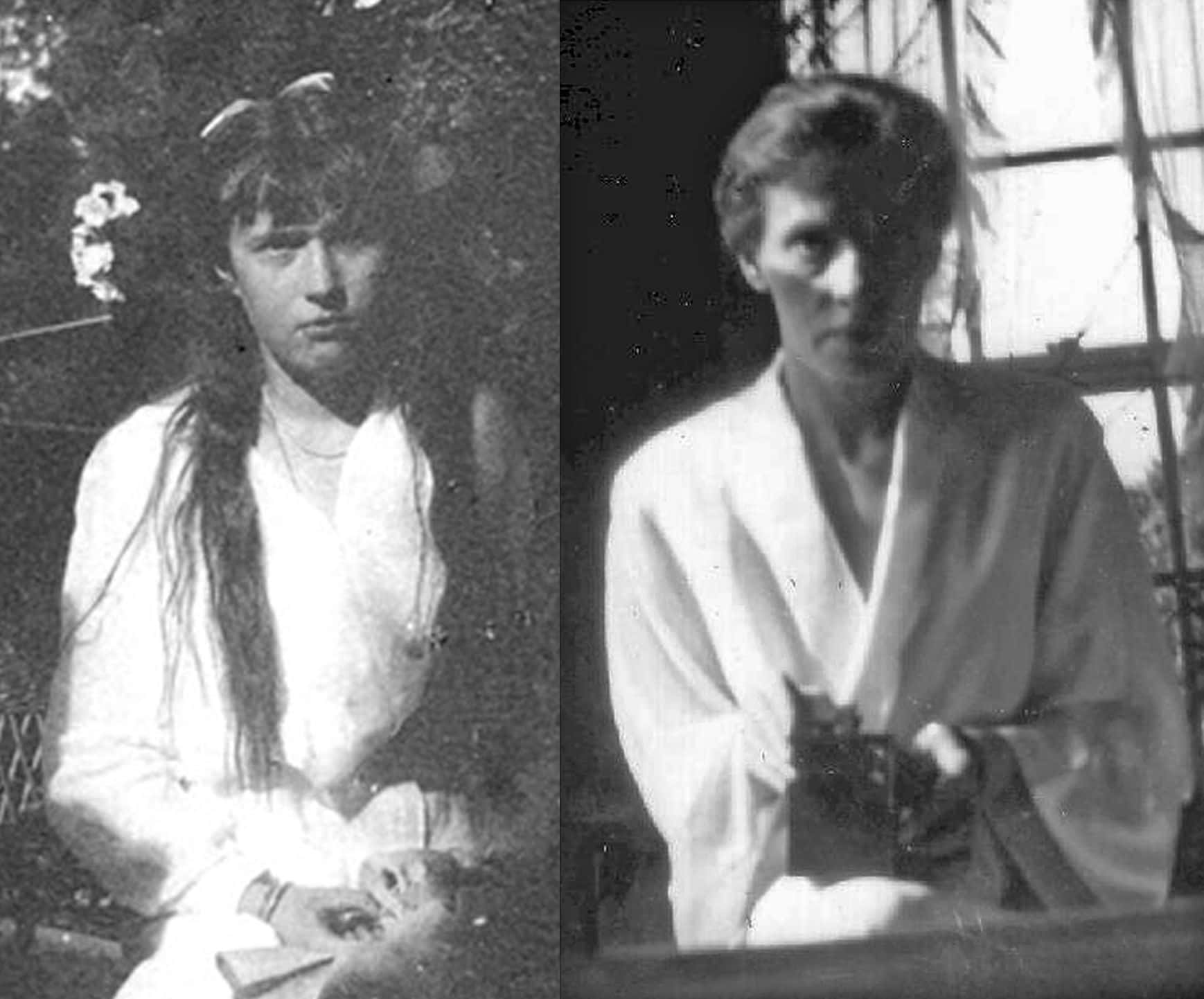 Pinterest
Pinterest
74. Imposter!
Not everybody who visited Anna Anderson believed that she was Anastasia. For one thing, she didn’t recognize people she should have known. Her tutor Pierre Gilliard said Anderson was a “vulgar adventuress,” and Anastasia’s grandmother, the Dowager Empress Marie, refused to even meet with her. Anastasia’s aunt Olga did visit, but stated that she was “looking at a stranger".
Everyone wanted so deeply to believe the girl had been saved, but ultimately they could find nothing to cling to. In 1994, 10 years after her passing, her tissue was compared with a sample from Prince Philip, but there was no match, disproving her claim once and for all. It's now widely believed that Anderson was actually Franziska Schanzkowska, a mentally-ill Polish factory worker.
75. Hidden Gems
Alexandra Romanov must have had a hint at what was coming, and before their execution she had the girls sew jewels into their clothes to potentially finance a rescue. On the night of their deaths, perhaps believing rescue was imminent, the girls dressed in their special clothing, which in the end only prolonged their gruesome fate. The initial hail of bullets likely immediately ended the lives of her mother and her sisters, but not Anastasia, perhaps because the jewels sewn into her clothing made the bullets ricochet. However, the guards finished her off.
76. Tragic Hope
When Anastasia’s grandmother the Dowager Empress Marie heard that her family had been slain, she didn’t believe it. She hadn’t been there that night, already having escaped to Crimea with other refugees, and she was certain that they got out of Russia and that the Bolsheviks were keeping the truth from her. While Marie's daughter believes that in her heart of hearts she did eventually accept their deaths, Marie appeared to hold on to the belief that they had somehow escaped until the day she passed on.

77. Friend and Confidant
Because of their secluded lifestyle, the Romanov children did not have peers to play with, but they did have their mother’s holy man and counselor Grigori Rasputin. The girls were taught to view Rasputin as their friend and confidant. It was revealed after their deaths that the girls all wore amulets containing an utterly chilling image: Rasputin’s picture.
78. Mystery Solved?
When the mass grave of the Romanov family was discovered, Alexei and Anastasia’s bodies weren’t with the rest of them, leading to questions about what might have happened to her and if she had indeed survived. In 2007, an amateur archaeology group discovered two sets of remains under a mound close to where the rest of the bodies were buried. The bones are believed to belong to Anastasia and Alexei, perhaps closing the book on her tragic story once and for all.

79. A Picture is Worth a Thousand Fortunes
Most remember Edie Sedgwick as the iconic muse of Andy Warhol. Less people remember that she was also of wealthy birth: her mother descended from Southern Pacific Railroad family money while her father’s lineage had connections to the Declaration of Independence’s signing! Alas, not all the money of the world saved this model from her final fate. She was discovered lifeless from a fatal does of barbiturates at the age of 28.
80. Grand-Damsel in Distress
In 1959, Brooke Astor inherited a $60 million estate from her notoriously belligerent husband, Vincent Astor. Brooke enjoyed an illustrious career as a philanthropist, but her male relatives proved to be her tragic undoing.
In 2006, Brooke’s grandson filed a lawsuit to remove care of the elderly Brooke from his own father, her son Anthony Marshall. The suit alleged that Marshall committed elder abuse by letting Brooke live in squalor, withholding her medication, and selling prized assets. Rescuing his grandmother cost grandson Phillip Marshall a total of $9 million (and favors from rich friends like Annette de la Renta and even Henry Kissinger), but he declared zero regrets.
81. Secret Struggle
Nancy Cunard was a literary-minded heiress who aimed higher than her mix of British and American gentility. Instead of spending her money on luxury goods, she was a socialist activist who rubbed elbows (and other body parts) with the literary leaders of her day. Her verbose lovers included Ernest Hemingway, Langston Hughes, Ezra Pound, and even James Joyce.
The heavyweight in star power, however, was dangerously underweight. Behind the stylish lifestyle, Cunard struggled for years with anorexia. She weighed just 57 pounds at the time of her passing in 1965.
82. A Cinderella Litigation Story
You can’t blame a former First Lady's stepdaughter for feeling a little eclipsed. Christina Onassis is best remembered as Greek businessman Aristotle Onassis' child and heir—and of course, as the legendary Jacqueline Kennedy Onassis' step-daughter. Unfortunately, Christina reportedly never liked her step-mom. After Aristotle’s passing, Jackie Kennedy had to fight to get a settlement from her ex's family.
It took two years of lawsuits for the socialite to receive $26 million in exchange for surrendering all other claims to Christina, her heiress stepdaughter. Christina was described by a paternal stepsister as “one of those people who would never be happy. She would become impatient. It had all come too easily—all the money, houses all over the world, few real responsibilities".
83. Good Help is Hard to Believe
Teenage nicotine heiress Doris Duke lived a long but controversial life until the age of 80. After two failed marriages, the passing of her daughter, and a long struggle with pill addiction, Duke changed her will at the last second and left $1.2 billion to her butler, Bernard Lafferty. This raised eyebrows and the accusation that Lafferty conned the feeble Duke into a change of heart. Despite talk, charges were never filed again the fortunate helper.
84. Life Doesn’t Always Intimate Art
A Little Princess (1995) stars a real-life American “princess". As a child, Liesel Anne Pritzker, or “Liesel Matthews” on-screen, starred in the movie about an unfortunate orphan with big dreams. In real life, however, the child star was one of the heiresses to the Hyatt hotel fortune. Among her holdings is even Royal Caribbean Cruise Lines. A far cry from the orphanage, eh?
But in a seemingly-mandatory poor little rich girl moment, Pritzker encountered troubles because of her wealth. While still a teenager, she entered a high-profile court battle with her own father and some cousins. She alleged that they had mismanaged her and her brother's money. After a dramatic and lengthy trial, Pritzker and her brother won. They each received $280 million in cash, and that doesn't even include the new trusts they controlled.
Somehow I don't think Pritzker's family will try to mismanage her funds again...
 A little princess,Warner Bros.
A little princess,Warner Bros.
85. Don’t Do as I Do
Bobbi Kristina Brown came into her family fortune under the worst circumstances. Her mother, music legend Whitney Houston, fatally drowned in her own bathtub in 2012. The 19-year-old Brown inherited her mother’s estate of $20 million. However, this windfall could only bring cold comfort to Brown for a short while.
In 2015, Bobbi Kristina's unconscious body was found in a bathtub—yes, like her mother. Tragically, the 22-year-old perished after six months in a comatose state. Her fortune was subsequently passed up to her grandmother and maternal uncles.
86. Bilt for Sadness
Gloria Vanderbilt lived an extraordinary life. A wealthy heiress, she was married four times and had romances with the biggest names in show business, but she was a powerhouse all on her own and a force to be reckoned with. Nonetheless, all the triumphs and riches in the world couldn't save her from tragedy.
87. When I Look Into My Father's Eyes
Vanderbilt was the only child of railroad magnate Reginald Claypoole Vanderbilt and Gloria Morgan Vanderbilt. Almost from the beginning, her father had a special connection to his daughter: when he first saw his baby girl, Reginald was reported to have exclaimed, "It is fantastic how Vanderbilt she looks! See the corners of her eyes, how they turn up?"
88. Daddy's Gone
Reginald, however, was haunted by demons, and his enormous wealth simply wasn't enough to buy his way out of his problems: He was a desperate alcoholic, and when Gloria was only 18 months old, he lost his life to cirrhosis of the liver.
89. A Hefty Stipend
With her father's demise, Gloria became a very rich baby. The young Vanderbilt and her half sister were now heiresses to a fantastic fortune equivalent to about $71 million dollars in today's money. Of course, the months-old Vanderbilt was too young to control her estate, so her extravagant, beautiful mother Gloria Morgan—who was just 21 years old at the time—took over "responsibility" of the vast sum...with disastrous consequences.
90. Friends in High Places
For years, Vanderbilt's mother carted the young girl to and from Paris while she took part in lavish soirees and shopping trips. All this high-rolling, however, came to a tumultuous halt. Gloria's paternal aunt, Gertrude Vanderbilt Whitney, got sick of seeing the little girl stuck in the middle of this spendthrift, immoral lifestyle. She demanded custody of young Gloria and declared Mama Morgan unfit to parent—an allegation that kicked off one of the most dramatic periods of young Gloria's life.
91. The Trial of the Century
The ensuing custody battle over the little Vanderbilt was called "The Trial of the Century". It ignited the press, who published story after story digging deeper into the circumstances of Gloria's baby-socialite life, with many focusing on the Vanderbilts' great wealth in contrast to her mother's debauched, irresponsible lifestyle.
For example, it was said that Vanderbilt's mother frequently caroused with lovers in the house, and often left naughty photos lying around where young Gloria could surely stumble across them.
92. Et Tu, Mother?
Even the young widow's own mother commented on her socialite daughter's inability to nurture the child. As she said, “[my] daughter paid absolutely no attention to little Gloria. She devoted herself exclusively to her own pleasures. … took long trips to Germany and other places [and]... seldom wrote to me or inquired about the baby". During the trial, it was even alleged that Gloria's mother had recently tried to teach the little girl how to mix cocktails.
93. The Money Train Stops Here
Eventually, Gertrude Vanderbilt Whitney won primary custody, though Gloria's mother was permitted visitation rights to her daughter. Nonetheless, every visit was closely watched to make sure there was no attempted wheeling and dealing going on during their time together. All this did not help endear little Gloria to her mother: once she had full control over her trust fund, she temporarily cut off her mother from any allowance.
94. High School Dropout
Still, it was far from a happy ending for Gloria when she was living with her aunt. Almost as soon as Vanderbilt went to live with Gertrude, the vibrant girl felt stifled by the strict rules of the house and the stuffy way of living her aunt promoted. As a result, when she was only 17 years old, Vanderbilt left high school early to go live with her mother in Beverly Hills.
95. First Comes Love...
In 1941, just after her impulsive teen move to Hollywood, the young Vanderbilt met Pat Di Cicco, an acting agent and probable mobster. The young couple were quickly married, though the union dissolved after just four years for horrific reasons. Vanderbilt later confessed that Di Cicco was abusive, and often called her “Fatsy Roo” in a derogatory manner. It was probably a good thing they never had children together, as she also said that he “would take my head and bang it against the wall,” and frequently gave her black eyes.
96. Blended Family
Just weeks after divorcing Di Cicco, Vanderbilt became engaged to an, er, odd match: Leopold Stokowski. The Polish conductor was more than four decades older than the young, beautiful Vanderbilt, and he already had three children from previous marriages running afoot. Vanderbilt became an instant stepmom, and later had two sons with Stokowski in the course of their 10-year marriage.
97. Third Time Isn't the Charm
Always a mover and a shaker, Vanderbilt's third marriage was to Sidney Lumet, the director of acclaimed films such as 12 Angry Men and Network; at the time, she was his second wife. Yet there was no happy ending to be had here, either: their (childless) marriage broke apart in 1963 after seven years together.
98. Fourth and First
Despite her rocky martial history, Vanderbilt really got it right with her fourth husband, Wyatt Emory Cooper. Though Vanderbilt herself wasn't new to the altar, it was the first and only time that Cooper ever married—and it stuck. They had two children together: Carter Cooper and famous CNN news anchor Anderson Cooper.
99. A Tragic End
Though the iconic pair were married for 15 happy years, their bliss came to a tragic end. In late 1977, Cooper suffered from a heart attack and had to go in to have open heart surgery in January, 1978. Sadly, he didn't make it past the operating table, and perished in the hospital. He was mourned both by Gloria and his young sons—but as you'll see, the tragedy wasn't over...
100. The Tax Man Cometh
In the 1980s, Vanderbilt nearly suffered a financial ruin. It came out that her fraudulent lawyer had never paid the IRS on her behalf, and she owed millions in back taxes. She had to sell two homes to rectify the situation, and took the man to court to get the money back. It was a long, drawn-out process—with the lawyer actually dying during litigation—but she was eventually awarded the win, even though she never recovered the money.
101. Life in the Racy Lane
Vanderbilt really did do it all—including writing sensual novels. Obsession: An Er*tic Tale came out in 2009, and Vanderbilt claimed that once she decided to write it, the words just "fell on the page". There were some protestations from her more highbrow friends who thought she was going to ruin her reputation. Apparently, Vanderbilt had to restrain herself from saying "Oh, goody!" to this.
102. Gloria Golightly
Do you like Audrey Hepburn in Breakfast at Tiffany's? Well, you might have Vanderbilt to thank. Some speculate that Truman Capote's character Holly Golightly in the original novel was based on none other than Vanderbilt herself.
103. The Loss of a Son
In 1988, Vanderbilt's son Carter took his own life at the desperately young age of 23—but the tragedy only gets worse from there. Vanderbilt actually witnessed the event: she saw him out on the terrace of their apartment ready to jump off the ledge, but he motioned for her not to come close to him. She fell to her knees and begged him not to do it, but she couldn't save him.
According to Vanderbilt, Carter had been sleeping in the house just before the incident and woke up in some kind of fugue state. He then ran around the apartment before consigning himself to his ultimate, sad fate.
104. Behind Closed Doors
Little Gloria's custody trial was so sensitive and heated that the judge frequently forced everyone to exit the room so that the girl could give her testimony without being pressured by her family members. In these closed-door meetings, bystanders frequently heard wailing and crying coming from inside the courtroom—and even though these were private sessions, the press got ahold of one tragic detail.
In one such communique, little Gloria apparently admitted to the judge that she was lonely when she was with her mother, and that she wished she could go live with her aunt instead.
105. Come to Auntie
This vulnerable admission was very likely what won the custody battle for Gertrude Vanderbilt Whitney, but that doesn't mean that justice was served on that fateful day. When she looked back on this painful time in her life, Gloria made a heartbreaking confession: she had memories of her aunt actually coaching her on the testimony.
106. Remembering Gloria
On Monday, June 17, 2019, Gloria Vanderbilt passed on in her Manhattan home at the ripe old age of 95. Vanderbilt had been diagnosed with stomach cancer earlier in the month. On a heart-rending CNN memorial to his late mother, Anderson Cooper gave a tear-filled speech about what Vanderbilt meant to both him and the world. As he said, “The last few weeks, every time I kissed her goodbye, I would say, ‘I love you, Mom. She would look at me and say, ‘I love you, too. You know that.’ And she was right. I did know that".
107. Who’s Your Daddy?
Princess Henrietta of England converted to Roman Catholicism for her marriage to Phillipe, Duke of Orleans. He repaid her by having multiple affairs with men. Upon the birth of their first daughter, there were rumors that Princess Henrietta had repaid adultery, and that the baby was not Phillipe’s at all! Some candidates for daddy include King Louis XIV, aka Phillipe’s own brother, or even the Comte de Guiche, AKA, Phillipe’s own ex-lover.
Sources: 1, 2, 3, 4, 5, 6, 7, 8, 9, 10, 11, 12, 13, 14, 15, 16, 17, 18, 19, 20, 21, 22, 23, 24, 25, 26, 27, 28, 29, 30, 31, 32, 33, 34, 35, 36, 37, 38, 39, 40, 41, 42, 43, 44, 45, 46, 47, 48, 49, 50, 51, 52, 53, 53, 55, 56, 57, 58, 58, 60, 61, 62, 63, 64

